Date 3 July 1778 | ||
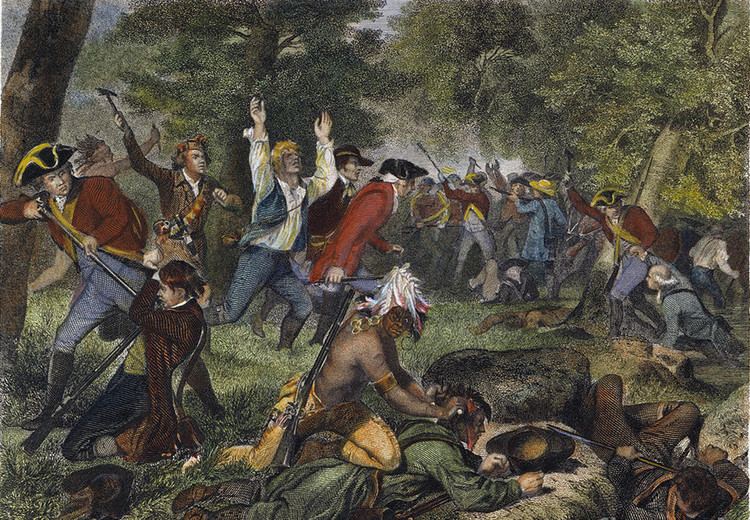 | ||
3 killed8 wounded about 340 killed5-20 captured Combatants Similar American Revolutionary War, Cherry Valley massacre, Battle of Oriskany, Battle of Crooked Billet, Battle of Newtown | ||
Battle of wyoming
The Battle of Wyoming (also known as the Wyoming Massacre) was an encounter during the American Revolutionary War between American Patriots and Loyalists accompanied by Iroquois raiders that took place in the Wyoming Valley of Pennsylvania on July 3, 1778. More than three hundred Patriots were killed in the battle.
Contents
- Battle of wyoming
- The bloody rock battle of wyoming pennsylvania
- Background
- Battle
- Aftermath
- Fall of Fort Pittston
- Sullivan Expedition
- Legacy
- Order of battle
- References
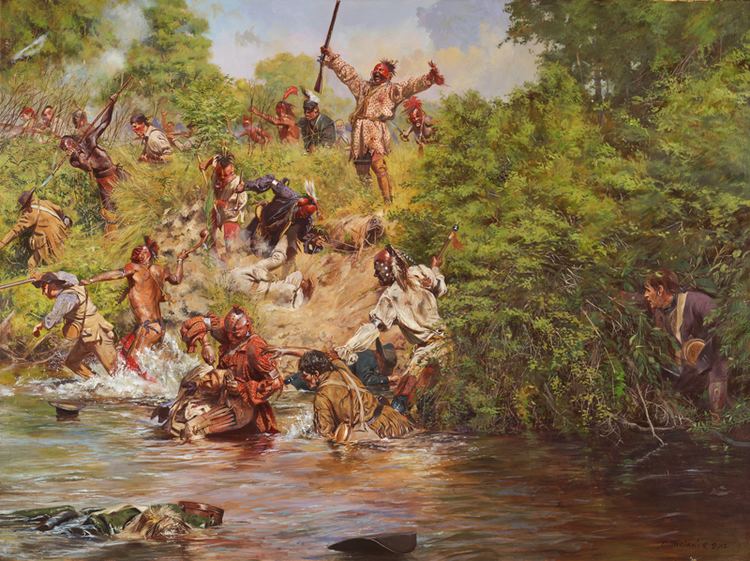
After the battle, settlers claimed that the Iroquois raiders had hunted and killed fleeing Patriots before using ritual torture against thirty to forty who had surrendered, until they died.
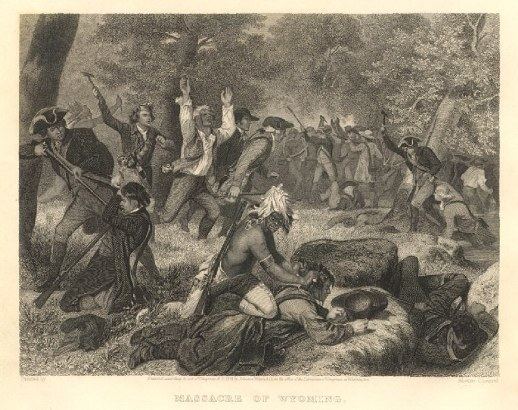
The bloody rock battle of wyoming pennsylvania
Background
In 1777, British General John Burgoyne led a campaign to gain control of the Hudson River in the American Revolutionary War. Burgoyne was weakened by loss of time and men after the Battle of Oriskany and was forced to surrender after the Battles of Saratoga in October. News of his surrender prompted France to enter the war as an American ally. Concerned that the French might attempt to retake parts of New France they had lost in the French and Indian War (something they did not know the Franco-American Treaty of Alliance specifically forbade), the British military adopted a defensive strategy in Quebec. They recruited Loyalists and enlisted Indians allies to conduct a frontier war along the northern and western borders of the Thirteen Colonies.
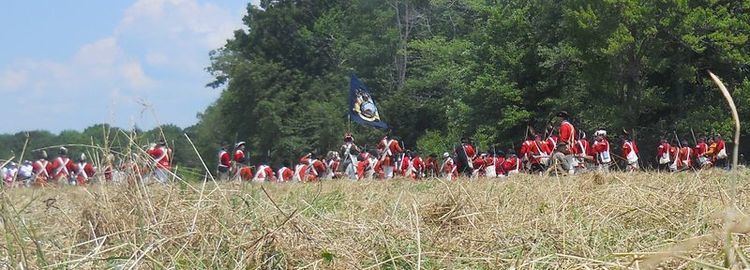
Colonel John Butler recruited a regiment of Loyalists, while Seneca chiefs Sayenqueraghta and Cornplanter recruited primarily Seneca warriors, and Joseph Brant recruited primarily Mohawks for what became a guerrilla war against the American frontier settlers. By April 1778 the Seneca were raiding settlements along the Allegheny and Susquehanna Rivers, and by early June the three groups met at the Indian village of Tioga, New York. Butler and the Seneca decided to attack the Wyoming Valley, while Brant and the Mohawks (who had already raided Cobleskill in May) targeted settlements further north.
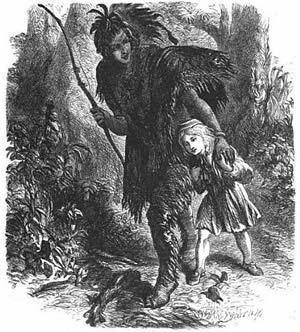
American military leaders, including Washington and Lafayette, also sought to recruit Iroquois, primarily as a diversion to keep the British in Quebec busy. These recruitment attempts, however, met with more limited success. The Oneida and Tuscarora were the only tribes the Six Nations to become Patriot allies.
Battle

The British forces arrived in the valley on June 30, having alerted the settlers to their approach by killing three men working at an unprotected gristmill on June 28. The next day Colonel Butler sent a surrender demand to the militia at Wintermute's (Wintermoot) fort. Terms were arranged that the defenders, after surrendering the fort with all their arms and stores, would be released on the condition that they not again bear arms during the war. On July 3, however, the British saw that the defenders were gathering in great numbers outside of Forty Fort. William Caldwell was engaged in destroying Jenkin's fort, and with the American militia a mile away, Butler organized an ambush. He ordered Fort Wintermute set on fire, and the Patriots, believing it signified a British retreat, advanced rapidly. Butler told the Seneca to lie flat on the ground so as not to be seen. The militia advanced to within a hundred yards of the British rangers and fired three volleys at them. The Seneca rose to their feet, fired one time, and then charged the militia to engage in hand to hand combat.
Accounts indicate the battle lasted about 45 minutes. An order to reform the Patriot line instead turned into a frantic rout as the inexperienced militiamen panicked and began to run. It became a deadly footrace, from which only about sixty Patriots escaped. The victorious Loyalists and Iroquois killed almost all who were captured, and only 5 prisoners were taken alive. Butler reported that 227 scalps were taken by his Native American allies.
The next morning Colonel Nathan Denison agreed to surrender Forty Fort and two other posts, along with what remained of his militia. Butler paroled them on their promise to take no part in further hostilities. Non-combatants were spared and only a few inhabitants were molested after the forts' surrender.
Colonel Butler wrote: "But what gives me the sincerest satisfaction is that I can, with great truth, assure you that in the destruction of the settlement not a single person was hurt except such as were in arms, to these, in truth, the Indians gave no quarter." An American farmer wrote: "Happily these fierce people, satisfied with the death of those who had opposed them in arms, treated the defenseless ones, the woman and children, with a degree of humanity almost hitherto unparalleled". Nevertheless, Colonel Denison and his men did not honor their parole, and within the year they would participate in attacks on Iroquois villages.
According to one source, 60 Patriot bodies were found on the battlefield and another 36 on the line of the retreat. All were buried in a common grave.
Aftermath
Out of 1,000 men available, John Butler reported only two Loyalist Rangers and one Indian killed, and eight Indians wounded. He claimed that his force took 227 scalps, burned 1,000 houses, and drove off 1,000 cattle plus many sheep and hogs. Of the 60 Continentals and 300 militiamen involved, only about 60 escaped the disaster, though Graymont states about 340 killed. The Iroquois were enraged at the accusations of atrocities they said they had not committed, and at the militia taking arms after being paroled. Later that year, they further retaliated in the Cherry Valley massacre.
Reports of the massacres of prisoners and atrocities at Wyoming infuriated the American public. Afterward, Colonel Thomas Hartley arrived with Hartley's Additional Continental Regiment to defend the valley to try to harvest the crops. They were joined by a few militia companies, including that of Captain Denison, who violated his parole to join the force. In September, Hartley and Denison ascended the east branch of the Susquehanna with 130 soldiers, destroying Indian villages as far as Tioga and recovering a large amount of plunder taken during the raid. They skirmished with the hostile Indians and withdrew when they learned that Joseph Brant was assembling a large force at Unadilla.
Fall of Fort Pittston
Connecticut Continentals (Patriots), led by Captain Jeremiah Blanchard and Lieutenant Timothy Keyes, held and maintained a fort in Pittston (only several miles away from the battlefield). On July 4, 1778 (one day after the Battle of Wyoming), a group of British soldiers took over the fortress and some of it was destroyed. Two years later, the Continentals stormed the fortification and recaptured it. From then on it was under Patriot control until the end of the war in 1783, with the signing of the Treaty of Paris. Today a marker stands at the site where the fort once stood.
Sullivan Expedition
In summer 1779, the Sullivan Expedition commissioned by General George Washington, methodically destroyed 40 Iroquois villages, and an enormous quantity of stored corn and vegetables throughout upstate New York. The Iroquois never recovered from the damage inflicted by Sullivan's soldiers, and many died of starvation that winter. The tribes allied with the British continued to raid Patriot settlements until the end of the war.
Legacy
The massacre was depicted by the Scottish poet Thomas Campbell in his 1809 poem "Gertrude of Wyoming". Because of the atrocities involved, Campbell described Joseph Brant as a "monster" in the poem, although it was later determined that Brant was not present. Brant was at Oquaga on the day of the attack.
The western state of Wyoming received its name from the U.S. Congress when it became Wyoming Territory in 1868, much to the puzzlement of its residents.
The battle and massacre is commemorated each year by the Wyoming Commemorative Association, a local non-profit organization, which holds a ceremony on the grounds of the monument dedicated to the battle. The Wyoming Monument is the site of a mass grave containing the bones of many of the victims of the battle and massacre. The commemorative ceremonies began in 1878, to mark the 100th anniversary of the battle and massacre. The principal speaker at the event was President Rutherford B. Hayes.
The annual program has continued each year since then on the grounds. One hundred and seventy-eight names of Patriots killed in the battle are listed on the Wyoming Monument, and the names of about a dozen militia who were killed or died in captivity a day or so prior to the main battle. A possible explanation for the difference between the number of names on the monument (178) and the reported number of scalps taken in the battle (227) is that allegedly numerous civilians (perhaps as many as 200)—instead of surrendering to Colonel Butler—elected to flee and died of exposure in a swamp known as the "Shades of Death" after the battle.
Order of battle
In the battle:
